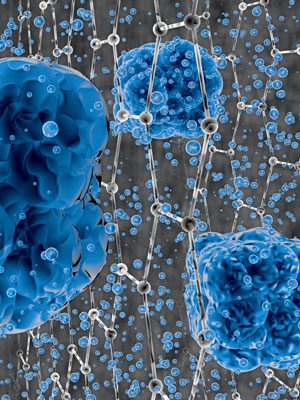Project Plan
Main goal of the project
Real-time detection of toxic and warfare chemical substances

.
The main goal of the Project is the demonstration of a novel low cost sensor for the real-time detection of toxic and warfare chemical substances, based on the monitoring of the environment-sensitive electrical impedance of ultrathin nanomembranes (Electrical Impedance Spectroscopy)
In the demonstrators, these nanomembranes will be integrated into a customized printed circuit board (test-vehicle), to be connected to the EIS instrument (either a high-precision lab instrument or an existing low-cost commercial chip). Two main classes of substances will be targeted: (i) an aggressive warfare agent; (ii) a heavily toxic industrial pollutant.
Main objectives of the project
Obj.1 Material synthesis and characterization
To assess reliable techniques to synthesize ultrathin and ultra-light sensing nanomembranes from two classes of 2D materials:
- (i) carbon-related materials (graphene, graphitic, glassy and pyrolytic carbon);
- (ii) van der Waals heterostructures (transition metal dichalcogenides, hexagonal boron nitrides).
To investigate the sensitivity of the nanomembranes and to improve it by means of functionalization and/or novel arrangements (i.e., metasurfaces)
Obj.2 Device integration and sensor demonstration
To assess reliable techniques to integrate the membranes into electronic boards. To design, fabricate and validate the sensor demonstrators based on monitoring the electrical impedance variations (proof-of-concept). To investigate the potential industrial applicability of the proposed sensor
Obj.3 Circuit modelling and signal processing
To derive a reliable equivalent circuit model enabling the device-level analysis, design optimization, and signal features retrieval. To derive a reliable signal processing procedure for a robust real-time detection, also in presence of noise
Objective 1 falls in the area “Material science” of the SPS “Special call for Proposal on Security-related Advanced Technologies”, whereas objectives 2-3 fall in the area “sensors and detectors”. Given the multidisciplinary nature of the project, it also addresses the area “technology convergence”.
The expected outcomes of the project are:
Applied research
- 1.Production of highly sensitive to chemical substances ultrathin nanomembranes, based on carbon films and on van der Waals heterostructures.
- 2.Assessed techniques to integrate the films into printed circuit boards
- 3.Prototypes of gas sensors with nanomembranes
- 4.Device-level circuit model and signal processing protocols
Fundamental research
- 1.New techniques to fabricate membranes based on van-der-Waals structures and metasurfaces
- 2.Comparative study of the response of the fabricated nanomembranes to the targeted substances
- 3.Development of the knowledge in the electrical modelling, signal processing, and electrical characterization of electronic devices embedding nanomaterials
A general goal of this project is also that of creating a stable international network of competencies on the project topics, joining together academic teams with complementary expertise on materials, devices, modelling, and characterization, and industrial end-users.
Specifically and according to the new configuration of the partners, the project currently involves 2 research teams and 3 end users. The Partner Countries teams (CREATE, Italy and UEF, Finland) maintain the know-how and facilities for the nanomaterials synthesis. The NATO team (CREATE, Italy) has the expertise in applied electronics and electromagnetics, for modelling, designing, fabricating and validating the sensor. The end-users are Italian Companies involved in the market of defence and/or aerospace, and will drive and support the project in view of its potential industrial applications.
The end-user SENSICHIPS will make available its commercial sensing platform for the demonstrator. The end-user ARESCOSMO will provide support for validation, with special emphasis on the warfare agents detection. The end-user NANESA will give support on the fabrication and characterization of the nanomembranes.
Team Leaders

Prof. Antonio Maffucci
University of Cassino and Southern Lazio
CREATE Consortium, Naples – Italia
_______
NPD (NATO Country Partner Director)
_______
Full Professor of Electrotechnics with the Dept. of Electrical and Information Engi- neering at the University of Cassino and Southern Lazio, Cassino, Italy, and Research Associate at the National Institute of Nuclear Physics, INFN-LNF, Frascati, Italy. His research areas include computational electromagnetics, electromagnetic compatibility, distributed circuit and systems, nanoelectronics, and quantum circuits. He is the Coordinator of the EU- H2020 project “TERASSE” and of the NATO-SPS project “2DSENSE”.

Dr. Polina Kuzhir
Institute of Photonics
University of Eastern Finland, Joensuu – Finland
_______
Co-Director
_______
Senior researcher and a Marie Skłodowska – Curie fellow in the Institute of Photonics, University of Eastern Finland and the Head of Nanoelectromagnetics lab at the Belarusian State University. She is an internationally recognized expert in the field of graphene/2D materials, theoretical and experimental photonics. Her research focuses on theory and experimental validation of 2D materials-based passive and active devices, including detectors, filters, shields, polarizers, collimators and emitters.
